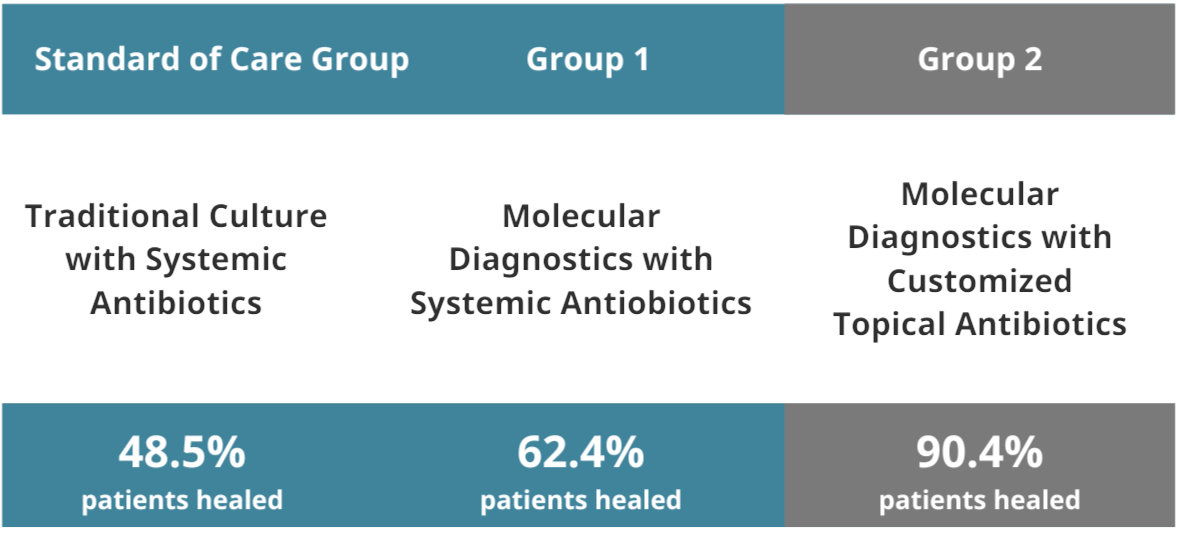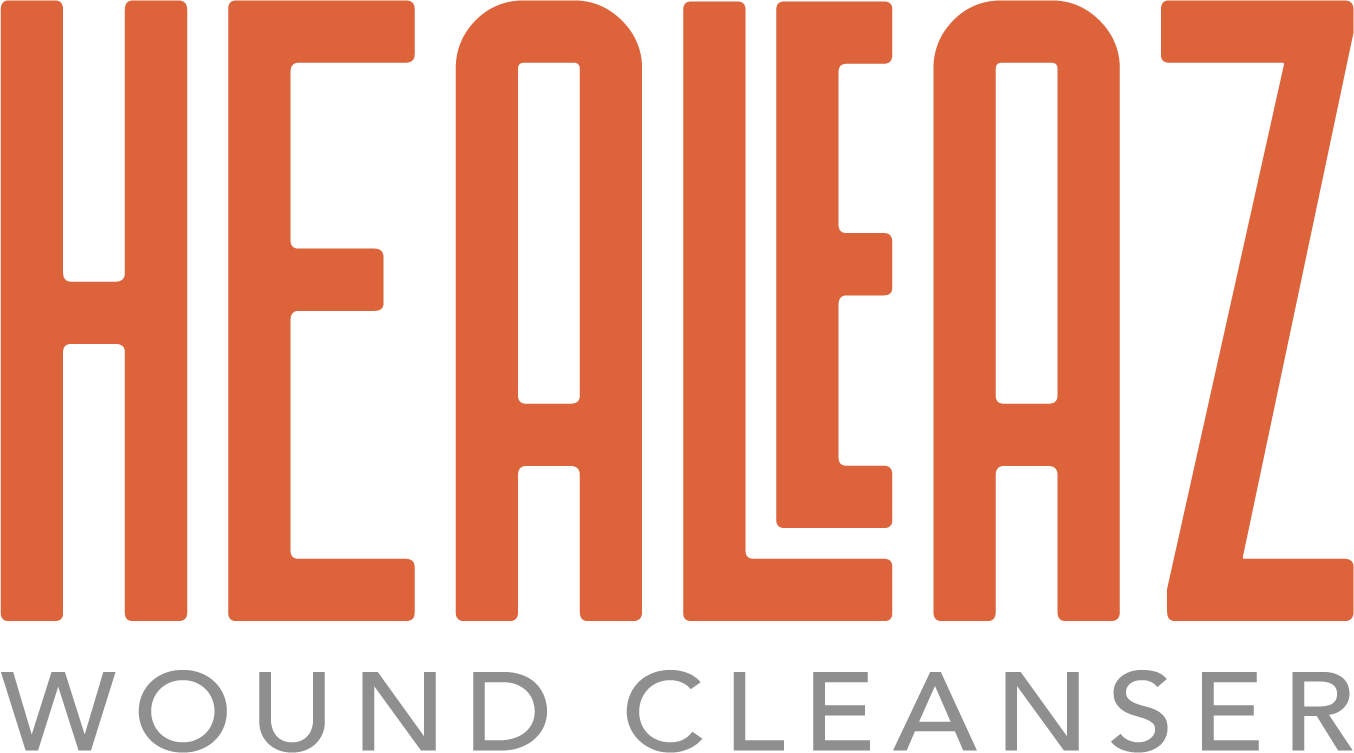
The BioFactor Wound Hygiene Program offers a systematic approach to wound chronicity management. To overcome barriers to wound healing, follow the FACTs.
Why Target Biofilms?
80%
Biofilms are identified in greater than 80% of biopsies of chronic wounds but only 6% of acute wounds. Biofilms are highly tolerant to antibiotics. Antibiotics only kill metabolically active bacteria
Malone, et al. Prevalence of Biofilms in Chronic Wounds: A Systematic Review and Meta-Analysis of Published Data. J Wound Care. 2016; 25:12, 1-12.

90.4%
Treatment group 2 patients were prescribed a TARGETED RX, personalized with topical therapeutics based on each patient’s specific polymicrobial census as identified by molecular diagnostics. All topical preparations contained antibiofilm agents; most contained antibiotics and some contained antifungal agents. 90.4% of patients healed completely during the 7 month study.
200%
Patients treated in Treatment group 2 had greater than 200% better odds of healing at any given time point compared with the other cohorts
Dowd, SE, et al. Molecular Diagnostics and Personalized Medicine in Wound Care: Assessment of Outcomes. J of Wound Care. 2011: 20:5, 232-239.
Follow the STATs
80%
Biofilms are identified in greater than 80% of biopsies of chronic wounds but only 6% of acute wounds. Biofilms are highly tolerant to antibiotics. Antibiotics only kill metabolically active bacteria
Malone, et al. Prevalence of Biofilms in Chronic Wounds: A Systematic Review and Meta-Analysis of Published Data. J Wound Care. 2016; 25:12, 1-12.
48.5%
Standard of Care Treatment Group patients were prescribed systemic antibiotics on the basis of empiric and traditional culture-based methodologies. All patients were evaluated for bioburden and primary treatments included commercially available antibiofilm agents. 48.5% of patients healed completely during the 7 month study.
90.4%
Treatment group 2 patients were prescribed a TARGETED RX, personalized with topical therapeutics based on each patient’s specific polymicrobial census as identified by molecular diagnostics. All topical preparations contained antibiofilm agents; most contained antibiotics and some contained antifungal agents. 90.4% of patients healed completely during the 7 month study.
45.9%
Patients prescribed a TARGETED RX time to complete closure decreased by 45.9% compared with standard of care group
200%
Patients treated in Treatment group 2 had greater than 200% better odds of healing at any given time point compared with the other cohorts
Dowd, SE, et al. Molecular Diagnostics and Personalized Medicine in Wound
Care: Assessment of Outcomes. J of Wound Care. 2011: 20:5, 232-239.
What is a chronic wound?
A wound is any break in the skin or deep tissue. Normally the skin heals quickly on its own. Wounds that don’t heal easily are called chronic wounds. They require special care to heal. Chronic wounds can result from:
Skin that breaks down when there’s too much pressure over a bony area (pressure ulcers)
Injury to the feet or legs from poor circulation (arterial or venous ulcers)
Loss of circulation and feeling due to diabetes (diabetic ulcers)
Why isn’t my wound healing faster?
Bacteria (germs) can slow healing. With open wounds, it’s easy for common bacteria from your skin to get inside. This is called contamination. Contamination can sometimes lead to infection. Infection means the bacteria are reproducing and invading the soft tissue and preventing healing.
If your provider suspects you have an infection, they will swab the wound and send to a lab to determine which bacteria have overgrown and created the infection. If an infection is present, the bacteria are often protected by biofilm. Until a biofilm is removed, the infection is more difficult to treat. Managing the biofilm and infection topically with cleansers and targeted topical prescription antibiotics can help.
Other factors that slow wound healing include:
Poorly balanced healing proteins in the wound bed (MMPs)
Poor nutrition, smoking, or obesity
Certain diseases, such as diabetes or diseases of the liver, kidney, or lungs
Certain treatments, such as chemotherapy or radiation
How can the BioFactor Wound Hygiene Program help my wound?
Our program is designed to educate our patients and families on good wound hygiene. If an infection is identified, we partner with your provider to offer products and customized topical antibiotic prescriptions to progress the wound to healing. The Targeted Rx topical antibiotic is compounded in an anti-biofilm base to “clean up” the wound by removing the biofilm, treating the identified infection, and preparing the wound bed to heal. To care for your infected wound step-by-step just Follow the FACTs.
Generally, to help heal faster, keep your wound clean, warm, and moist. This will make it easier for new tissue to grow.
Wash your hands. The most important thing you and your caregivers can do to prevent infection or spread further bacterial growth is to wash your hands. Use soap and water or an alcohol-based hand rub only if water is not available. Wash before and after cleaning or dressing your wound.
Keep a clean dressing on your wound. Dressings keep germs out and protect the wound from injury. They also help absorb fluid that drains from the wound that could damage the skin around it.
Be careful. Protect the wound from physical injury. Don’t let anything touch it or bump it.
Eat well. Eating the right foods gives your body the building blocks it needs to heal.
The BioFactor Wound Hygiene program offers a structured method to care for your infected wound. The Follow the FACTs step-by-step process at dressing changes will clean up your wound by:
cleansing debris and dead tissue
removing the biofilm protecting the bacteria
treating the overgrown bacteria with a Targeted Rx
prepping the wound bed and rebalancing the wound healing proteins (MMPs)
Targeted RX
Apply a thin-film topically directly to wound surface or sterile dressing upto daily as directed
by provider as part of BioFactor Wound Hygiene Program to:
Target patient’s polymicrobial census identified in the underlying infection
Prevent biofilm reformation with anti-biofilm base
Follow the FACTs
Focus HealEaz
to wet gauze and wash the wound and peri-wound area
Appropriate
debridement + refashioning of wound by practitioner as needed
Cleanse with HealEaz
to wash away remaining debris and rebalance MMPs in wound microenvironment
Targeted RX
in anti-biofilm base customized to treat pathogens identified layered with appropriate dressing for wound type
As part of the BioFactor Wound Hygiene program, your prescription from the pharmacy will contain both a wound cleanser and a topical compounded antibiotic prescription:

Wash wound and peri-wound surface using gentle force as tolerated as directed by provider as part of BioFactor Wound Hygiene Program to:
Cleanse, debride, and remove microorganisms from the wound and peri-wound surface.
Rebalance MMPs in wound microenvironment. Our active ingredient QBx™ is a synthetic composition of cations derived from a botanical material found in the ash of red oak bark which has been shown to therapeutically down regulate certain MMPs.*
Offer wound bed prep to moisten ahead of absorbent wound dressing application. QBX technology contributes to setting up a suitable environment to allow wounds to close.*
Offer biocompatible, convenient, no rinse formula in 2oz mist spray.
Up to 200x high levels of MMP activity in chronic wounds decrease as wounds
heal. MMP protease activities in chronic wound fluids are an average of 50X higher than in acute healing wounds and >200X higher in some chronic wounds.
Trengove, Stacy, et al. Analysis of the acute and chronic wound environments: the role of proteases and their inhibitors. Wound Rep Reg. 1999; 7, 442-452
High levels of active MMP-9 must be reduced to levels that are compatible with healing.
Ladwig, Robson, et al. Ratios of activated matrix metalloproteinase-9 to tissue inhibitor of matrix metalloproteinase-1 in wound fluids are inversely correlated with healing of pressure ulcers. Wound Repair Reg. 2002; 10, 26-37.
Frequently Asked Questions
Who are Customicro Clinical Services?
We are Clinician driven.
Customicro Clinical Services are supervised and administered by clinicians focused on antibiotic stewardship. We partner with pharmacies to dispense proprietary formulations and product options to manage the wound, sinus, and vaginal microenvironment including a 5R gut health program.
What does Customicro Clinical Services offer?
We service and administer solutions.
Our programs:
+ Offer personalized, patient-centered clinical formulations
+ Offer market leading specialized products
+ Offer a dedicated clinical pharmacist to support our partner providers
How do I partner with Customicro to offer their programs to my patients?
Please fill out our new accounts form and one of our team members will reach out to you as soon as possible. You can also contact us at directly at (480) - 490 - 8921.
Connect With Us
Customicro Clinical Services
10900 N Scottsdale Rd Ste 402, Scottsdale, AZ 85254
(480) - 490 - 8921
Our compounding pharmacy partner,
Customedico Pharmacy + Wellness
We are an independently owned compounding pharmacy dedicated to the provision of personalized medications to meet the unique needs of our patients. Please contact us with any questions or to participate in our programs.
10900 N. Scottsdale Rd #403, Scottsdale, AZ 85254
(480) - 946 - 9477
(480) - 946 - 1345

2025 © Customicro Clinical Services
All Rights Reserved